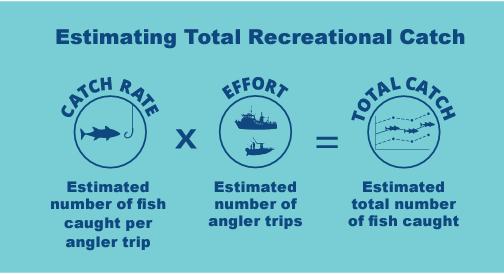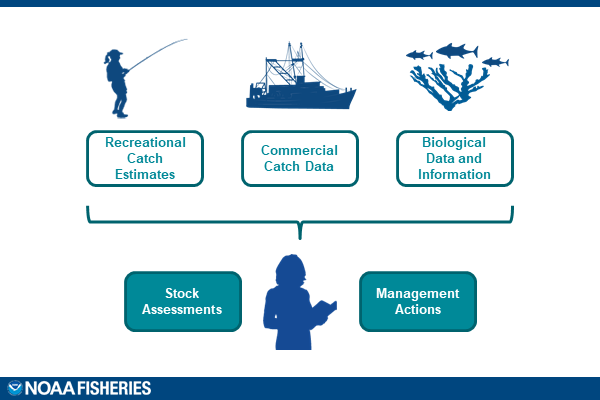Marine Recreational Information Program
Overview
Through the Marine Recreational Information Program (MRIP), NOAA Fisheries and its state and regional partners, use in-person, telephone, and mail surveys to estimate the number of trips saltwater anglers take and the number of fish they catch. When combined with other data such as commercial catch, biological information (like length and age), and observer data, recreational catch and effort estimates help scientists conduct robust stock assessments and managers sustainably manage Atlantic coast fisheries.
Percent Standard Error (PSE)
Full statistical estimates include point estimates (best educated estimate that lies in the mid-point of the full-range of potential estimates) and an estimate of precision, which indicates confidence in how close the point estimate is to the actual population value. One key metric used to represent precision is an estimate’s percent standard error, or PSE, which is the standard error, expressed as a percentage of that estimate.
The higher an estimate’s Percent Standard Error, or PSE, the larger the margin of error around the estimate, which means there is more uncertainty in the estimate.
MRIP cautions use of the estimate in fisheries management when the PSE is over 30, and does not support use of the estimate when the PSE exceeds 50.
Precision can be attributed to a variety of factors including insufficient sample sizes (interviews) for species infrequently encountered, as well as changes in angler behavior, life history characteristics of a stock, and large-scale weather events.
For highly imprecise estimates, MRIP recommends aggregation (e.g., across states, geographic regions, fishing modes, and/or years). Aggregating data is a common statistical approach to increase sample sizes over time and smooth spikes or anomalies in the data.
To help visualize how PSEs relate to estimates of harvested fish, a PSE of 50 on a point estimate of 100,000 fish could reflect potential actual harvest of between 0 and 200,000 fish.”
Recreational Fishing Data Collection
In the Atlantic region, MRIP administers three general surveys to collect data to produce general recreational catch and effort estimates:
1. The Access Point Angler Intercept Survey (APAIS) is an in-person intercept survey conducted at marinas, boat ramps, beaches, fishing piers, and other publicly accessible fishing sites. Trained samplers from state agencies interview anglers as they complete their fishing trips and collect information about the number, size, weight, and species of fish caught (kept or released). The success of the surveys relies on the participation of the anglers sampled. Because it’s not practical or possible to intercept each of the millions of recreational anglers fishing along the US coast, each sampled trip may represent dozens, hundreds, or even thousands of trips. Sample surveys allow MRIP to draw reasonable conclusions about the full recreational fishing community.
2. The Fishing Effort Survey (FES) is a mail survey that collects private boat and shore fishing activity information about fishing activity, or effort, from households in coastal states.
To sample, NOAA Fisheries uses a U.S. Postal Service list of residential addresses matched to the National Saltwater Angler Registry, which is a database of licensed anglers. This creates a sampling frame of licensed and unlicensed households, which are sampled at different rates. This allows MRIP to sample more frequently from households more likely to report fishing, while still maximizing the chances of obtaining a representative cross-section of all households. The FES replaced the Coastal Household Telephone Survey in 2018.
3. The For-Hire Survey (FHS) is a telephone survey that collects effort information from for-hire (party/charter) vessel representatives. Data from the FHS is used to develop estimates of the number of angler fishing trips taken on for-hire vessels that are not required to submit federal Vessel Trip Reports (VTRs), such as those that only hold state permits. To produce complete MRIP for-hire effort estimates, the FHS estimates are then added to the VTR census counts of angler trips for the federally permitted vessels.
The APAIS survey generates catch rate information (average numbers of species caught per trip), and the FES and FHS/VTRs generate effort information (number of trips). APAIS data are also used to apportion effort between areas (inland, ocean near-shore, ocean beyond 3 miles) and account for out-of-state fishing activity. This information is combined to generate total catch estimates.
In addition, MRIP administers the Large Pelagics Survey, a specialized suite of three surveys (intercept, telephone, and biological) that produces catch and effort estimates for large pelagic and highly migratory species.
Learn More:
•Types of Recreational Fishing Surveys
•How the Marine Recreational Information Program Samples Anglers
Recreational Catch Estimates
MRIP uses data collected from the surveys described above to produce estimates of total recreational catch. While the actual statistical process is complicated, in essence these estimates are generated by multiplying catch rate (the average number of a particular species caught per fishing trip) by effort (the total number of fishing trips taken).
Learn More:
•Survey Statistics Overview
•Marine Recreational Information Program Estimation Methods
•Survey Design and Statistical Methods for Estimation of Recreational Fisheries Catch and Effort (PDF)

How to Access Recreational Data
There are several ways to access the information used to estimate recreational fishing activity. You can download full datasets or use the MRIP query tool to filter catch, effort, and participation data by time series, geographic area, species, mode, and other characteristics.
Get Recreational Data:
•Recreational Fishing Data and Statistics Queries Landing Page – a searchable database of catch, effort, and fishing participation statistics.
•Recreational Fisheries Query Tool – use this link to open the query tool directly
Fisheries Management and Recreational Fishing Data
The recreational fishing data MRIP produces are critical to inform and support the state, regional, and federal fisheries stock assessment and management processes. The total catch estimates produced by MRIP are combined with other information including commercial catch, biological information, and observer data to help scientists assess the health of fish stocks. Through a public process that includes stakeholder input, fisheries managers use this information to set regulations that strive to balance access to the resource while ensuring its sustainability.

In addition to producing recreational fishing estimates, MRIP provides critical support— such as access to technical resources, expert statistical support, and funding— to states and regional partners to meet their unique regional recreational fishing data needs. This support includes certification of state-sponsored surveys and funding to improve state survey implementation. MRIP also reviews and approves regionally-led recreational fishing data collection priorities through Regional Implementation Plans developed by the program’s coalition of partners including Fisheries Information Networks, states, fishery management councils and interstate commissions. These plans serve as roadmaps to identify and prioritize survey design research and development, as well as potential funding opportunities.
Learn More:
•Fisheries Management and the Marine Recreational Information Program
•Atlantic States Marine Fisheries Commission (ASMFC)
•New England Fishery Management Council (NEFMC)
Contacts
For questions please, contact:
MRIP
- Sarah Lazo, NOAA Fisheries, MRIP Communications Specialist, sarah.lazo@noaa.gov, (301) 427-8181
ACCSP
- Alex DiJohnson, Recreational Team Lead, alex.dijohnson@accsp.org, (703) 842-0792
- Geoff White, ACCSP Director, geoff.white@accsp.org, (703) 842-0785
